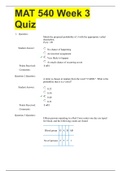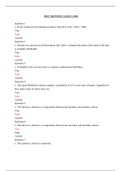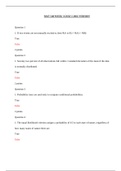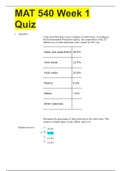Mat 540 week 3 quiz Study guides, Class notes & Summaries
Looking for the best study guides, study notes and summaries about Mat 540 week 3 quiz? On this page you'll find 5 study documents about Mat 540 week 3 quiz.
All 5 results
Sort by

-
MAT 540 Week 7 Quiz 3
- Exam (elaborations) • 7 pages • 2022
- Available in package deal
-
- $7.49
- + learn more
MAT 540 Week 7 Quiz 3 MAT540 Week 7 Quiz 3

-
ASHFORD UNIVERSITY MAT 540 Week 3 Quiz(LATEST) WITH COMPLETE SOLVED SOLUTIONS GRADE A+
- Exam (elaborations) • 5 pages • 2020
- Available in package deal
-
- $5.49
- + learn more
Match the proposed probability of A with the appropriate verbal description A letter is chosen at random from the word "CAROL". What is the probability that it is a vowel? Fifteen persons reporting to a Red Cross center one day are typed for blood, and the following counts are found: For two events A and B, the following probabilities are given. Use the appropriate laws of probability to calculate: For two events A and B, the following probabilities are given. P(A) = 0.5, P(B) = 0.15, P(A | ...
MAT 540 Week 1Quiz MAT 540 Week 2Quiz MAT 540 Week 3 Quiz MAT 540 Week 4 Quiz

-
MAT 540 WEEK 3 QUIZ 2 2016
- Exam (elaborations) • 6 pages • 2019
-
- $10.49
- + learn more
Question 1 1. If two events are not mutually exclusive, then P(A or B) = P(A) P(B) True False 2 points Question 2 1. Seventy two percent of all observations fall within 1 standard deviation of the mean if the data is normally distributed. True False 2 points Question 3 1. Probability trees are used only to compute conditional probabilities. True False 2 points Question 4 1. The equal likelihood criterion assigns a probability of 0.5 to each state of nature, regardless of how many...

-
MAT 540 WEEK 3 QUIZ 2 2016 VERSION
- Exam (elaborations) • 8 pages • 2018
-
- $15.49
- + learn more
Question 1 1. If two events are not mutually exclusive, then P(A or B) = P(A) P(B) True False 2 points Question 2 1. Seventy two percent of all observations fall within 1 standard deviation of the mean if the data is normally distributed. True False 2 points Question 3 1. Probability trees are used only to compute conditional probabilities. True False 2 points Question 4 1. The equal likelihood criterion assigns a probability of 0.5 to each state of nature, regardless of how many...




